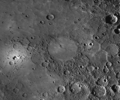File:Copland crater.png
Vai alla navigazione
Vai alla ricerca

Dimensioni di questa anteprima: 723 × 600 pixel. Altre risoluzioni: 290 × 240 pixel | 579 × 480 pixel | 926 × 768 pixel | 1 235 × 1 024 pixel | 2 272 × 1 884 pixel.
File originale (2 272 × 1 884 pixel, dimensione del file: 2,5 MB, tipo MIME: image/png)
Cronologia del file
Fare clic su un gruppo data/ora per vedere il file come si presentava nel momento indicato.
| Data/Ora | Miniatura | Dimensioni | Utente | Commento | |
|---|---|---|---|---|---|
| attuale | 20:40, 17 dic 2010 |  | 2 272 × 1 884 (2,5 MB) | LobStoR | reduced palette from 24-bit RGB to 8-bit greyscale |
| 09:44, 30 apr 2010 |  | 2 272 × 1 884 (4,6 MB) | Bryan Derksen | {{Information |Description={{en|1=Instrument: Narrow Angle Camera (NAC) of the Mercury Dual Imaging System (MDIS) Scale: Copland crater has a diameter of 208 kilometers (129 miles) Projection: This image is a portion of the NAC approach mosaic from Mercur |
Pagine che usano questo file
Le seguenti 2 pagine usano questo file:
Utilizzo globale del file
Anche i seguenti wiki usano questo file:
- Usato nelle seguenti pagine di ca.wikipedia.org:
- Usato nelle seguenti pagine di en.wikipedia.org:
- Usato nelle seguenti pagine di en.wikibooks.org:
- Usato nelle seguenti pagine di es.wikipedia.org:
- Usato nelle seguenti pagine di fr.wikipedia.org:
- Usato nelle seguenti pagine di www.wikidata.org:
- Usato nelle seguenti pagine di zh.wikipedia.org:


